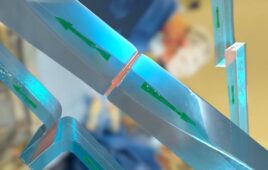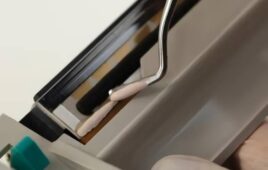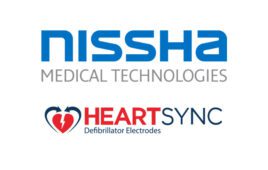From implantable medical devices to external insulin pumps, medical device engineers can choose from a wide range of off-the-shelf and customized silicone adhesives for many applications. [Photo courtesy of NuSil Avantor]
The right high-purity silicone adhesive can optimize medical device manufacturing and have a life-changing impact on patients.
By James Darlucio, NuSil Technology — part of Avantor
From next-generation prostheses to cutting-edge diabetes care, medical device manufacturers are at the forefront of developing innovative technologies that have the potential to change and save patients’ lives.
Various materials and components come together to form the device. For many manufacturers, silicone is an ideal adhesive to use in device assembly due to its proven biocompatibility, ability to bond to various substrates, and stability over a wide range of conditions.
Choosing the right silicone adhesive is essential since the integrity and performance of the medical device rely on the durability of the adhesive over the life of the device. Medical device engineers must select a silicone adhesive that not only meets manufacturing considerations like cure rate and manufacturing throughput but also complies with biocompatibility requirements of the end-use device.
For medical device applications, manufacturers typically select from two main types of cure systems, which specify the type of cross-linking mechanism involved with the cure of silicone adhesive formulation: condensation cure systems and addition cure systems.
Condensation cure silicone adhesives
Condensation cure systems are traditionally one-part systems that do not require any mixing to be applied, but do require exposure to moisture to cure. This characteristic makes them well-suited for use in devices with temperature-sensitive components like electronics or thermoplastics. Condensation cure silicone adhesives are also ideal for applications that require bonding silicone to other silicones, glass, metals and plastics.
- Cure characteristics: Several factors impact one-part adhesive cure, such as humidity levels (20-60% relative humidity recommended) and cure temperature (25-50° C recommended). Other influences include cross-sectional thickness and the amount of surface area exposed to air.
- Application considerations: One-part silicone adhesives tend to have slower cure rates than two-part adhesives, which can impact device assembly throughput. During the curing process, these formulations can also produce byproducts such as alcohols, mild acids or other volatile substances, causing the adhesive to shrink from its original volume. Liberating byproducts may require manufacturing areas to be ventilated or properly exhausted.
- Specialty applications: Adhesives can be supplied dispersed in a compatible solvent to help facilitate a specific process or application. Due to its low viscosity, a solvent-dispersed adhesive can be ideal for conformal coating applications that require thin sections or for intricate areas that are otherwise hard to access.
Addition cure silicone adhesives
These two-part silicone adhesives do not require ambient moisture to cure. This characteristic makes them ideal for medical devices for which the device assembly can tolerate heat and is sensitive to cure byproduct. Since it can cure at ambient conditions and at higher temperatures, addition cure adhesives provide a high degree of versatility and device manufacturing efficiency. These adhesives can cure in an enclosed environment that have little or no access to air. Like moisture cure systems, addition cure silicone adhesives adhere to a range of substrates, and manufacturers can use them for applications like encapsulating, potting or sealing.
- Cure characteristics: Two-part silicone adhesives consist of two components: Part A and Part B. Curing begins by mixing two components in a 1∶1 mix ratio. Unlike one-part adhesives, these formulas release practically no byproducts or leaving groups and therefore, are less likely to shrink as they cure.
- Application considerations: Addition cure silicones provide work times that can range from 15 minutes to 72 hours, depending on the product formulation. Since it’s addition cure chemistry, increasing the manufacturing temperature can accelerate the cure rate. Addition cure adhesives are available in ready-to-use cartridges, so the material can be dispensed through a static mix tip directly into a mold cavity without needing additional equipment for mixing.
- Specialty applications: When an assembly process requires very fast curing after the adhesive is applied, manufacturers can increase the cure rate by increasing temperatures. For example, high-temperature addition cured adhesives can be fully cured at temperatures and times ranging from 10 minutes at 116° C to 2 minutes at 150° C.
Surface preparation
Cleaning and priming the surface can remove surface contaminants and improve the surface wettability to impact long-term adhesion. When developing a surface preparation procedure, consider these factors:
- Substrate cleaning: Contaminants including finger oils, dust particles, mold release agents and machine oils on metal parts can negatively impact the adhesive’s curing process. Proper cleaning methods prepare the surface by removing these contaminants. Clean the surface mechanically or by manually wiping it with an appropriate solvent like isopropyl alcohol, and allow it to properly air dry prior to the next stage of the device assembly.
- Silicone primer: Silicone primers are used to promote adhesion between two non-bonding surfaces. Primers usually consist of one or more reactive silanes that have two different reactive groups: one compatible with the substrate and the other with the adhesive. These different groups form a compatible interface between the incompatible substrates and promote adhesion. The primer forms a very thin polymeric film on the surface of the substrate. The appropriate primer alters the surface energy to the substrate to improve adhesion.
- Surface treatments: Understanding surface energy (or wettability) of the component substrate is crucial, especially if different substrates are being joined. A last resort to improving adhesion if cleaning and surface priming isn’t sufficient would be to employ a surface treatment like plasma or corona. Ultimately, the surface treatment method depends on the type of substrate and to what degree that substrate needs modification of its surface energy.
Biocompatibility and purity
Device engineers must consider a high-purity, medical-grade material when choosing silicone adhesives. The formulation should conform with applicable ISO and USP testing protocols, as well as provide resistance to oxidation, shear stresses and chemical attack from the device end application use. In addition, the silicone adhesive should be able to withstand sterilization by ethylene oxide, dry heat or other standard techniques without much impact on property and device performance. It is also important to select a silicone adhesives manufacturer able to provide supporting documentation, such as information on facilities and sterilization processes, with Master Files filed with the FDA.
Material selection is critical when developing innovative medical device technologies. From optimizing device manufacturing to making a potentially life-changing impact on patients’ lives, choosing the right high-purity silicone adhesive may help unlock a medical device’s potential.
James Darlucio is senior technologist for biomaterials at NuSil Technology, part of Avantor.
How to submit a contribution to MDO
The opinions expressed in this blog post are the author’s only and do not necessarily reflect those of Medical Design & Outsourcing or its employees.




